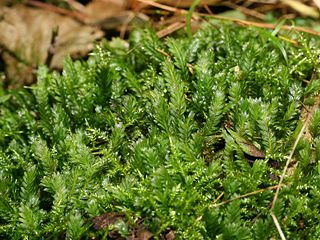
Fissidens adianthoides, the maidenhair pocketmoss, is a North American moss in the family Fissidentaceae. It was first described by Johann Hedwig in 1801. The Nitinaht First Nations of Vancouver Island have used maidenhair moss to bandage wounds. It was named by the Anglo-Saxons based on its resemblance to pubic hair.
The least gerbil is a species of rodent in the subfamily Gerbillinae. It is native to Ethiopia, Kenya, Somalia, South Sudan, and Tanzania.
The small pencil-tailed tree mouse or lesser pencil-tailed tree mouse is a species of arboreal rodent in the family Muridae. It is endemic to Borneo where it is only known from Sabah and Sarawak (Malaysia) and from southern Kalimantan (Indonesia), although it likely occurs more widely.

The lesser ranee mouse is a species of rodent in the family Muridae. It is found on the island of Borneo and the Palawan region (Philippines). Its natural habitat is subtropical or tropical dry forests.
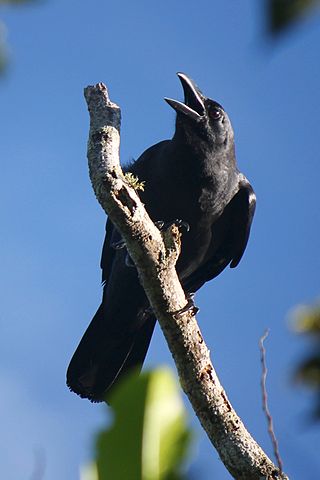
The Sunda crow, formerly known as the slender-billed crow, is a passerine bird of the family Corvidae, in the genus Corvus. It is found from Malaysia to Borneo. The violet crow has been shown to be distinct genetically and separated as Corvus violaceus. The small crow has been split as Corvus samarensis and the Palawan crow has also been split as Corvus pusillus.
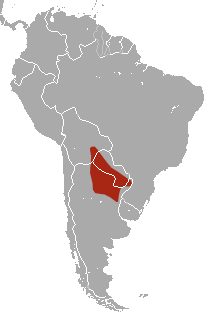
The common fat-tailed mouse opossum is a species of opossum in the family Didelphidae. It occurs in Argentina, Bolivia, and Paraguay in chaco and Andean foothill habitats. Its head-and-body length is about 75 to 120 mm, and its tail length is about 90 to 134 mm. Its dorsal fur is brownish gray, and its ventral fur is yellowish to white. The legs and cheeks are the same color as the ventral surface. Its tail is sharply bicolored. A ring of faintly darker fur surrounds each eye. Its tail often lacks fat deposits, but does not always.
Micropteropus is a genus of bat in the family Pteropodidae. It contains the following species:

Peters's dwarf epauletted fruit bat is a species of megabat in the family Pteropodidae. It is found in Angola, Benin, Burkina Faso, Burundi, Cameroon, Central African Republic, Chad, Republic of the Congo, Democratic Republic of the Congo, Ivory Coast, Equatorial Guinea, Ethiopia, Gabon, Gambia, Ghana, Guinea, Guinea-Bissau, Kenya, Liberia, Mali, Niger, Nigeria, Rwanda, Senegal, Sierra Leone, Sudan, Tanzania, Togo, Uganda, and Zambia. Its natural habitats are subtropical or tropical moist lowland forests and moist savanna.

The convex horseshoe bat is a species of bat in the family Rhinolophidae. It is found in Malaysia and Laos.
Fissidens hydropogon is a species of moss in the family Fissidentaceae. It is a critically endangered species endemic to Ecuador.

Fissidens is a genus of over 480 species of haplolepideous mosses (Dicranidae) in the family Fissidentaceae.

Omocestus viridulus, known in the British Isles as the common green grasshopper, is a Palearctic species of grasshopper in the subfamily Gomphocerinae.

Lestes viridulus, the emerald-striped spreadwing, is a damselfly species in the family Lestidae, the spreadwings. It is native to Bangladesh, India, and Thailand.

Fissidens limbatus commonly known as Herzog's pocket-moss, is a moss in the family Fissidentaceae. This species is found growing in high elevations in tropical America in addition to the US, Mexico and Canada. Montagne first collected F. crispus in 1838.
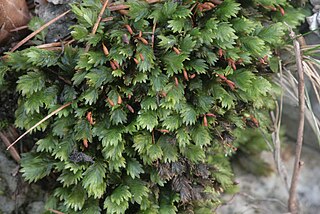
Fissidens dubius, commonly known as the rock-pocket moss, is a species of moss belonging to the family Fissidentaceae. First described by Palisot de Beauvois in 1805 from material collected in Philadelphia, it is a relatively large moss growing up to 5 cm (2 in) tall that forms loose to dense mats on calcareous substrates. The species is characterised by its serrated leaf margins, pale border of thick-walled cells, and typically dioicous reproduction. It has a broad global distribution across Europe, North and South America, Asia, North Africa, and New Zealand, occurring in various habitats from lowlands to alpine zones, particularly in shaded locations on basic soils and rocks. While morphologically similar to F. adianthoides, F. dubius is distinguished by its smaller leaf cells and irregularly thickened leaf tips. The species is classified as Least Concern due to its stable populations and absence of major threats.

Fissidens taxifolius, the common pocket moss, is a species of moss in the family Fissidentaceae. First described by Johann Hedwig in 1801, it is a small to medium-sized moss that typically grows in dense, yellowish-green to dark green tufts. The species is characterised by its distinctive flattened appearance, with leaves arranged in two opposite rows resembling tiny fern fronds, and by its pointed leaf tips with projecting central nerves. It can grow in artificial light and is known to form extensive turfs in suitable conditions.
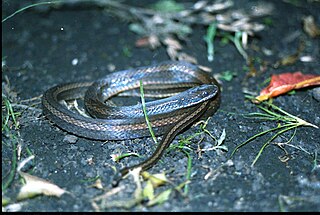
Coniophanes fissidens, the yellowbelly snake, is a species of snake in the family Colubridae. The species is native to Mexico, Guatemala, Honduras, Belize, Nicaragua, El Salvador, Costa Rica, Panama, Ecuador, Peru, and Colombia.
Fissidens celticus, also known by its common name Welsh pocket-moss, is a species of moss in the family Fissidentaceae. It was discovered in 1958 in Pembrokeshire by A.H. Norkett and was first described as a new species by Jean Paton in 1965.












